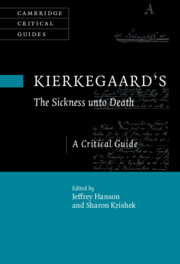Book contents
- Kierkegaard’s The Sickness unto Death
- Cambridge Critical Guides
- Kierkegaard’s The Sickness unto Death
- Copyright page
- Contents
- Contributors
- Acknowledgments
- Abbreviations
- Introduction
- Chapter 1 Kierkegaard’s Place of Rest
- Chapter 2 Publishing The Sickness unto Death
- Chapter 3 Kierkegaard on the Self and the Modern Debate on Selfhood
- Chapter 4 From Here to Eternity
- Chapter 5 Kierkegaard’s Metaphysics of the Self
- Chapter 6 The Experience of Possibility (and of Its Absence)
- Chapter 7 Sin, Despair, and the Self
- Chapter 8 Sin and Virtues
- Chapter 9 Despair as Sin
- Chapter 10 Fastening the End and Knotting the Thread
- Chapter 11 Despair the Disease and Faith the Therapeutic Cure
- Chapter 12 The Long Journey to Oneself
- Chapter 13 Accountability to God in The Sickness unto Death
- Bibliography
- Index
- Cambridge Critical Guides
Chapter 1 - Kierkegaard’s Place of Rest
Published online by Cambridge University Press: 26 August 2022
- Kierkegaard’s The Sickness unto Death
- Cambridge Critical Guides
- Kierkegaard’s The Sickness unto Death
- Copyright page
- Contents
- Contributors
- Acknowledgments
- Abbreviations
- Introduction
- Chapter 1 Kierkegaard’s Place of Rest
- Chapter 2 Publishing The Sickness unto Death
- Chapter 3 Kierkegaard on the Self and the Modern Debate on Selfhood
- Chapter 4 From Here to Eternity
- Chapter 5 Kierkegaard’s Metaphysics of the Self
- Chapter 6 The Experience of Possibility (and of Its Absence)
- Chapter 7 Sin, Despair, and the Self
- Chapter 8 Sin and Virtues
- Chapter 9 Despair as Sin
- Chapter 10 Fastening the End and Knotting the Thread
- Chapter 11 Despair the Disease and Faith the Therapeutic Cure
- Chapter 12 The Long Journey to Oneself
- Chapter 13 Accountability to God in The Sickness unto Death
- Bibliography
- Index
- Cambridge Critical Guides
Summary
It is now recognized that important interpretative insights are to be gained from reading Kierkegaard’s pseudonymous works in tandem with the upbuilding writings, especially where these are closely connected in time or subject matter. In the case of The Sickness unto Death, a journal entry by Kierkegaard (NB13:79) indicates that the Three Discourses at the Communion on Fridays (“The High Priest,” “The Tax Collector,” and “The Sinful Woman”), published in autumn 1849, “respond to” Anti-Climacus, pseudonymous author of The Sickness unto Death. How do they respond? Kierkegaard writes: “I must have a place of rest, but I cannot rest on a pseudonym; and they respond to Anti-Climacus, and [to] the situation. The discourses for the communion on Friday are once and for all envisaged as the authorship’s place of rest.” This comment invites us to see the discourses as offering a kind of dialectical counterpoint to the argument of The Sickness unto Death, and the chapter explores in detail what this means and, specifically, what Kierkegaard means by “a place of rest.” In addition to the Three Discourses at the Communion on Fridays the chapter also draws on An Upbuilding Discourse (1850) and Two Upbuilding Discourses (1851) that are thematically connected with the discourses of autumn 1849.
Keywords
- Type
- Chapter
- Information
- Kierkegaard's The Sickness Unto DeathA Critical Guide, pp. 6 - 25Publisher: Cambridge University PressPrint publication year: 2022

